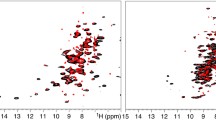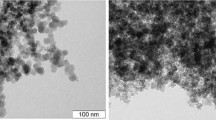Abstract
Protein immobilization in mesoporous silica nanoparticles has attracted much attention due to its wide range of applications. However, it remains largely unexplored how the use of mesopores can alter the spatial distribution of encapsulated biomolecules so as to improve pulsed dipolar spectroscopy sensitivity. Here, we performed electron spin resonance measurements for three different spin-labeled biomolecules (including two different peptides and a protein) encapsulated in various types of mesoporous materials differing in textural properties such as nanochannel length (e.g., 0.2–4 μm) and average pore diameter (e.g., 6–11 nm, approximately). Our results show that biomolecules are clustered somewhat upon the encapsulation into mesopores, and that due to the clustering, instantaneous diffusion plays an important role in the spin relaxation in nanochannels. The extent of molecular clustering exhibits a clear positive correlation with the length of nanochannels, whereas it shows little correlation with pore diameters. Among the materials studied, mesoporous materials with the shortest length of nanochannels are most effective to reduce spin clustering, thus suppressing the unwanted instantaneous diffusion and enhancing spin–spin relaxation time. This study has opened a possibility of improving the quality of pulsed dipolar spectroscopy with mesoporous silica nanoparticles.




Similar content being viewed by others
References
J. Liu, Q.H. Yang, C. Li, Chem. Commun. 51, 13731–13739 (2015)
S. Mitragotri, P.A. Burke, R. Langer, Nat. Rev. Drug Discov. 13, 655–672 (2014)
S. Isaksson, E.B. Watkins, K.L. Browning, T.K. Lind, M. Cardenas, K. Hedfalk, F. Hook, M. Andersson, Nano Lett. 17, 476–485 (2017)
S. Matsuura, M. Chiba, T. Tsunoda, A. Yamaguchi, J. Nanosci. Nanotechnol. 18, 104–109 (2018)
B.W. Chen, W. Qi, X.L. Li, C.H. Lei, J. Liu, Small 9, 2228–2232 (2013)
C.H. Lee, T.S. Lin, C.Y. Mou, Nano Today 4, 165–179 (2009)
S. Hudson, J. Cooney, E. Magner, Angew. Chem. Int. Ed. 47, 8582–8594 (2008)
N. Carlsson, H. Gustafsson, C. Thorn, L. Olsson, K. Holmberg, B. Akerman, Adv. Colloid Interface Sci. 205, 339–360 (2014)
M.R. Fleissner, M.D. Bridges, E.K. Brooks, D. Cascio, T. Kalai, K. Hideg, W.L. Hubbell, Proc. Natl. Acad. Sci. USA 108, 16241–16246 (2011)
J.S. Tong, P.P. Borbat, J.H. Freed, Y.K. Shin, Proc. Natl. Acad. Sci. USA 106, 5141–5146 (2009)
S.Y. Park, P.P. Borbat, G. Gonzalez-Bonet, J. Bhatnagar, A.M. Pollard, J.H. Freed, A.M. Bilwes, B.R. Crane, Nat. Struct. Mol. Biol. 13, 400–407 (2006)
C.J. Tsai, Y.W. Chiang, J. Phys. Chem. C 116, 19798–19806 (2012)
Y.C. Lai, Y.F. Chen, Y.W. Chiang, PLoS ONE 8, e68264 (2013)
K.J. Chang, Y.H. Kuo, Y.W. Chiang, J. Phys. Chem. B 121, 4355–4363 (2017)
Y.W. Huang, Y.C. Lai, C.J. Tsai, Y.W. Chiang, Proc. Natl. Acad. Sci. USA 108, 14145–14150 (2011)
S.A. Kozin, G. Bertho, A.K. Mazur, H. Rabesona, J.P. Girault, T. Haertle, M. Takahashi, P. Debey, G.H.B. Hoa, J. Biol. Chem. 276, 46364–46370 (2001)
Y.W. Huang, Y.W. Chiang, Phys. Chem. Chem. Phys. 13, 17521–17531 (2011)
K.J. Oh, S. Barbuto, N. Meyer, R.S. Kim, R.J. Collier, S.J. Korsmeyer, J. Biol. Chem. 280, 753–767 (2005)
Y.H. Kuo, Y.R. Tseng, Y.W. Chiang, Langmuir 29, 13865–13872 (2013)
C.H. Liu, C.Y. Lin, J.L. Chen, N.C. Lai, C.M. Yang, J.M. Chen, K.T. Lu, J. Catal. 336, 49–57 (2016)
P.H. Ku, C.Y. Hsiao, M.J. Chen, T.H. Lin, Y.T. Li, S.C. Liu, K.T. Tang, D.J. Yao, C.M. Yang, Langmuir 28, 11639–11645 (2012)
M. Pannier, S. Veit, A. Godt, G. Jeschke, H.W. Spiess, J. Magn. Reson. 142, 331–340 (2000)
A. Zecevic, G.R. Eaton, S.S. Eaton, M. Lindgren, Mol. Phys. 95, 1255–1263 (1998)
R. Dastvan, B.E. Bode, M.P. Karuppiah, A. Marko, S. Lyubenova, H. Schwalbe, T.F. Prisner, J. Phys. Chem. B 114, 13507–13516 (2010)
P.P. Borbat, J.H. Freed, Methods Enzymol. 423, 52–116 (2007)
G. Jeschke, S. Schlick, Phys. Chem. Chem. Phys. 8, 4095–4103 (2006)
S. Ruthstein, A.M. Raitsimring, R. Bitton, V. Frydman, A. Godt, D. Goldfarb, Phys. Chem. Chem. Phys. 11, 148–160 (2009)
S. Ruthstein, A. Potapov, A.M. Raitsimring, D. Goldfarb, J. Phys. Chem. B 109, 22843–22851 (2005)
Y.W. Chiang, P.P. Borbat, J.H. Freed, J. Magn. Reson. 177, 184–196 (2005)
Y.W. Chiang, P.P. Borbat, J.H. Freed, J. Magn. Reson. 172, 279–295 (2005)
E.R. Georgieva, A.S. Roy, V.M. Grigoryants, P.P. Borbat, K.A. Earle, C.P. Scholes, J.H. Freed, J. Magn. Reson. 216, 69–77 (2012)
A.A. Nevzorov, J.H. Freed, J. Chem. Phys. 115, 2401–2415 (2001)
K.M. Salikhov, S.A. Dzuba, A.M. Raitsimring, J. Magn. Reson. 42, 255–276 (1981)
S.Y. Chen, C.Y. Tang, W.T. Chuang, J.J. Lee, Y.L. Tsai, J.C.C. Chan, C.Y. Lin, Y.C. Liu, S.F. Cheng, Chem. Mater. 20, 3906–3916 (2008)
M. Ferdousi, M. Pazouki, F.A. Hessari, M. Kazemzad, J. Porous Mater. 23, 453–463 (2016)
S.Y. Chen, Y.T. Chen, J.J. Lee, S. Cheng, J. Mater. Chem. 21, 5693–5703 (2011)
Acknowledgements
This work was supported by Grants from the Ministry of Science and Technology of Taiwan (105-2628-M-007-005 and 106-2627-M-007-009) and the Frontier Research Center on Fundamental and Applied Sciences of Matters at NTHU. All of the CW/pulse ESR measurements were conducted in the Research Instrument Center of Taiwan located at NTHU.
Author information
Authors and Affiliations
Corresponding author
Electronic supplementary material
Below is the link to the electronic supplementary material.
Rights and permissions
About this article
Cite this article
Lai, YC., Chang, A., Yang, CM. et al. An Assessment of the Use of Mesoporous Silica Materials to Improve Pulsed Dipolar Spectroscopy. Appl Magn Reson 49, 1201–1216 (2018). https://doi.org/10.1007/s00723-018-1040-z
Received:
Revised:
Published:
Issue Date:
DOI: https://doi.org/10.1007/s00723-018-1040-z




